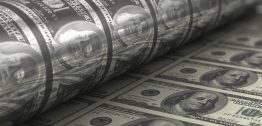The Fed is entertaining a disaster: Unwinding its $4.5 trillion balance sheet is expected to become part of its normalization efforts.
That’s a bad idea.
Michael Pento explains, “Since Quantitative Easing (QE) began back in November of 2008, the Fed’s balance sheet has grown from $700 billion to $4.5 trillion today. That is an increase of 540 percent [while] U.S. GDP has only managed […] a comparative measly blip in growth of just 29 percent.”
To state the obvious: Buying bonds does not stimulate the real economy. So, then why jack up the balance sheet?
“We hereby take these measures in the name of financial stability.”
That’s become a Fed mandate. Its members fully understand that crippling debt levels will kill the economy if they cannot be serviced with more, cheaper debt.
So, forgive me if I don’t fall out of my chair when I hear that it took $4 of debt to produce every $1 of U.S. GDP in 2016.

One could argue there was a time and place for using debt to grow an economy. But not anymore.
In fact, my colleagues at The Edelson Institute have talked about the looming debt crisis. And the way I see it, it’s far from over.
Consider …
Hoisington Investment Management reports that total domestic nonfinancial debt “surged to a record 254.8% of GDP in 2016, 5.6% greater than in 2009 when Lehman Brothers failed.” And total debt “amounted to 372.5% of GDP in 2016, compared with 251.9% of GDP in 2006.”
What about businesses? The news there is just as bad: “Business debt surged to a record 72.6% of GDP in 2016, for the first time eclipsing the prior peak of 70.2% reached in 2009.”
The fact is the U.S. economy is saturated with debt. And Dallas Federal Reserve Governor Robert S. Kaplan must have had a crisis of conscience earlier this year. After talking optimistically about U.S. growth, he offered up these eye-openers:

At some point, debt impedes growth. And there’s no doubt about it: We’re well past that point.
In fact, a few days ago, we talked about the financial disaster in Illinois. This week, its comptroller warned the governor that the state can no longer function without sacrificing its primary obligations and essential services.
You read that right: “No longer function” — their words, not mine.
All because it owes too much money and it is spending $600 million more than it takes in each month. Ridiculous!
In response, the Republican governor and leadership are willing to raise taxes so they may negotiate a budget with the Democrats. The same game is being played in the U.S. Congress, where Congressional Democrats are maneuvering around Republican tax-cut proposals because the debt ceiling is back in play.
So, what’s the inevitable consequence of government spending shenanigans like these? Even more debt. And don’t put it past government to reach into your pockets to make ends meet. And that means more taxes, more fees, more regulations. Even outright confiscations.
That’s why we are warning investors to steer clear of government debt. And any exposure to this market – if not short or in cash – should be in well-managed companies with little debt and stable business models. And of course, you could also protect some of your capital with gold.
Do right,
JR



Jo July 3, 2017
Agree with you, it does not take a rocket scientist to see that debt does not go away with more debt. The rule of the hole applies – stop digging before the walls collapse.
There is a funny facet. In Europe some central banks charge the banks to park money. That way these central banks “earn” money, reducing their debt.
Trump shows he does not understand a thing about money when he wants to add to the debt by giving his cronies tax breaks while increasing the budget for the unproductive military. On top of this he encourages other countries to pile up more debt. For what? To spend $4 for $1 in GDP growth? His bankruptcies show how good he is at handling money.
I do not understand why economists are hell-bent on growth. People either have everything they need or they cannot afford more because of their miserable incomes. There is no room for growth. Add automation and robots to that equation and most economists models are trash.
Rosa Mendez June 27, 2017
What about government or treasury only money market funds?
Rosa Mendez June 27, 2017
They have been a zero return proposition for investors. Seems like generational theft..
Steve Barbershores June 26, 2017
“Buying bonds does not stimulate the real economy. So, then why jack up the balance sheet?”
———————————————
The 4 trillion in bond purchases was not intended to stimulate the economy. It’s intent was to keep the economy from collapsing. By purchasing the bonds, the fed was able to control interest rates by driving them lower, and put cash in the hands of those that held the bonds. This, and other actions, kept the global bond market from crashing.
Hank June 24, 2017
Since the FED is not audited, do we really know what assets it actually has? Secondly the QE’s were just a way to recapitalize banks and cheap money for corporations to borrow , often resulting in stock buy backs. The tokens never reach the :real” economy thus low growth and continued depression. This coming recession within the depression may prove interesting as to how the world’s deep state central banks handle the crisis.
Mike June 24, 2017
Debt, debt, debt everyone likes to complain about debt. Routinely the complainers point to someone or something they don’t like to blame it on. No one ever takes responsibility for debt yet here it is. The fact is that every penny of debt is the result of elected officials enacting laws and measures that cost money or collects money. The first 192 years we spent almost 1 trillion dollars more than we collected. Over the next 36 years we spent 19 trillion dollars more than we collected. The 2016 deficit was 585 billion dollars. This is significant in that it happened with a growing economy and full employment. Since Americans vote for officials to give them what they want the blame for this debt lies squarely on those who elected government officials or did not participate in their electoral duties and accepted whatever came to pass.
f151 June 24, 2017
The debt is so out of control in Illinois that reportedly most if not all of the taxes collected in the state…..will have to be used to pay pensions. Years and years of Democrats giving huge annual raises to govt employees with votes given in return will soon come home to roost.
Frank Patterson June 24, 2017
It’s a no “brainer”, individuals, government entities or legal entities can not live on the credit card.
America has made an ass of itself trying to be the “shining city on a hill” showing off to all the world and other nations have taken all they can get. Now America is broke, having gone through all the trust funds and borrowing from vicious, scheming nations while being lead to ruin by our friends, England chief among them.
There is nothing new here, just look at the past few thousand years for “rise and fall” scenarios !
ron goddard June 23, 2017
yes it seems that all is bliss until something ‘happens’. then and only then people, governments etc. will say wow we didn’t see that coming! and it was all in ‘plain sight’, as they say now, for years.
there is a saying : don’t confuse me with the facts, my mind is made up. so people are dedicated, governments are dedicated, to ignoring all of the signals and proceed further down the tunnel, the rabbit hole or whatever. like lemmings.
how does one extricate oneself from the mire? if there is no share portfolio, little money to invest..then what? and that is the problem many millions face. government? more like mince pies. democracy = bankruptcy in today’s world. a bit harsh perhaps, but the reality………….
Harley Pattison June 23, 2017
J. R. C., I regret that the newsletter, G.R.H., with you as the Editor, has been cancelled. This leaves members to decide what to do with the stocks in it, as no one is watching them for us.
It,s sad that Brad H. & Niles M. have been terminated, along with the newsletters they edited. Now the members are left adrift. Shabby Mgmt. decisions. Harley Pattison Elite Member
Larry Horowitz June 23, 2017
JR, Yes, the Federal debt is high, but because interest rates have been kept low the ratio of interest payments on the debt to GDP is at a decade low. So, we are relatively stable while rates stay low. But the Fed raising rates and selling off assets threatens to raise LT interest rates, which can cause US budget collapse and inability to pay off government debt. Very high risk from here if the Fed starts unwinding.
Philip J. June 23, 2017
Gee, ” Daffy Donald ” loves debt and bankrupcies.
Leave it to Donald. ” Only HE can fix it. ” He said so himself,
and he has a lot of folks who believe him.
Phil Mahoney June 23, 2017
Been hearing this for years so when is it happening?
tommr June 23, 2017
I stated here several years ago that the FED will never SELL any of the assets on it’s balance sheet! That they will simply let them mature and “roll off”. This means that they will then be holding the cash received to redeem the bonds at par. They could just hold this cash, give back it to the US Treasury or they could even just extinguish it! You know, just the opposite of when they created it in the first place! They will NOT try to put these bonds up for sale on the open market.
I should probably point out that when the FED purchased these assets, they removed DEBT from the open economy and replaced it with cash created out of nothing. So now, they can either send this cash back out into again or keep it frozen at the FED.